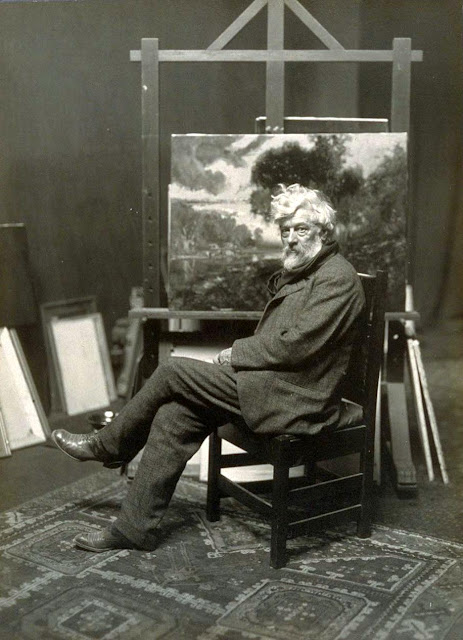WILLIAM KEITH
Scottish, 1838-1911 Born in Scotland in 1838, William Keith immigrated to New York with his family in 1850. As a teenager he apprenticed to a wood engraver before settling in San Francisco in 1859 where he set up an engraving shop on Clay Street. Keith became interested in painting in 1863 when he began studying with British still-life artist Samuel Marsden Brookes (1816-1892) at his Clay Street studio. Brookes was a founding member of both the Bohemian Club and the San Francisco Art Association.
Born in Scotland in 1838, William Keith immigrated to New York with his family in 1850. As a teenager he apprenticed to a wood engraver before settling in San Francisco in 1859 where he set up an engraving shop on Clay Street. Keith became interested in painting in 1863 when he began studying with British still-life artist Samuel Marsden Brookes (1816-1892) at his Clay Street studio. Brookes was a founding member of both the Bohemian Club and the San Francisco Art Association.
Later, Keith began studying watercolor painting under the guidance of his wife, artist Elizabeth Emerson (1838-1882), a distant relative of Ralph Waldo Emerson (1803-1882). Elizabeth encouraged his interest in pursuing a career in art, and in 1868 he gave up engraving to become a fulltime painter accepting commissions by the Northern Pacific Railroad to paint scenes along its routes in the Pacific Northwest, including scenes of Mount Hood and the Columbia River.
By 1869 Keith’s success with painting financed travel to Europe to study with the German Dusseldorf romantic landscape painters. On his first trip he met fellow art student William Hahn (1829-1887). In Paris he studied with the Barbizon School before returning to America to share a studio with Hahn in Boston before they both moved to San Francisco in 1872 where they continued to share a studio. German born William Hahn would become one of the best-known genre painters of the American West. On his return to San Francisco Keith met and forged a close friendship with Scottish naturalist John Muir (1838-1914). Keith and Muir later joined efforts in the unsuccessful campaign to save the Hetch-Hetchy Valley from becoming a reservoir. Art historian Dwight C. Miller has called the remarkable friendship between Muir and Keith as “one of the important cultural transactions of the period in California.”
After the death of his first wife, Keith married Mary McHenry (1855-1947), the first woman to graduate from Hastings Law School. In 1891 Keith began painting with Tonalist George Inness on excursions to Monterey and Yosemite. Keith and Inness were followers of the teachings of scientist turned occultist Emanuel Swedenborg whose mystic dreams were revealed during trances and meditation. Swedenborg influenced several important writers and artists of the day. In the 1880s and ‘90s the Swedenborgian minister Joseph Worcester urged Keith to paint spiritual visions and much of the artist’s late period was devoted to Swedenborgian visions of dream-like landscapes.
He became one of the wealthiest artists in the United States by the early 1900s. Keith seldom accepted male students and was known as an art teacher of emerging women artists whom he introduced to plein air painting at locales such as Lands’ End. After a second trip to Europe to study portrait painting in Munich, the Keith’s settled permanently in Berkeley, California and William commuted daily by ferry to his studio in San Francisco.
Keith was a very prolific artist painting over 4,000 oil paintings in his lifetime, half of which tragically burned in his studio in the earthquake and fire of 1906. When he died at home in 1911, he was both wealthy and famous. An entire room was dedicated to his work at The Panama Pacific International Exposition of 1915 and a special gallery dedicated to his life’s work. During the years proceeding his death, his wife Mary continued to work endlessly to secure women the right to vote on a national level. In addition to this work, Mary is also responsible for the gathering, recording, and archiving Keith’s paintings. She worked closely with Brother Cornelius, the founder of the Saint Mary’s College Museum of Art. Today, William Keith’s paintings serve as Saint Mary’s trademark collection as the museum cares for over 170 paintings and ephemera associated with the artist. The Keith Gallery at Saint Mary’s College in Moraga, California opened in 1934.
In addition to the gallery at Saint Mary’s College, Keith’s work can be found in public and private institutions such as: the Amon Carter Museum of American Art, the Anchorage Museum at Rasmuson Center, the Butler Institute of American Art, the Cantor Arts Center, the Chrysler Museum of Art, the Corcoran Gallery of Art, the Crocker Art Museum, the De Young Museum, the Farnsworth Art Museum, the Gilcrease Museum, the High Museum of Art, the Los Angeles County Museum of Art, the Metropolitan Museum of Art, the Monterey Museum of Art- Pacific, the Museum of Art at Brigham Young University, the Museum of Fine Arts, Boston, the Muskegon Museum of Art, the National Portrait Gallery, the North Carolina Museum of Art, the Oakland Museum of California, the Phippen Art Museum, the Portland Art Museum, Oregon, the Ruth Chandler Williamson Gallery, the San Diego Museum of Art, the San Francisco Museum of Modern Art, the Santa Barbara Museum of Art, the Sheldon Museum of Art, the Springville Museum of Art, the Stark Museum of Art, The Art Gallery, University of New Hampshire, The Brooklyn Museum of Art, The Columbus Museum of Art, Ohio, The Cummer Museum Of Art & Gardens, The Haggin Museum, The Nelson-Atkins Museum of Art, The Parthenon, The Society of California Pioneers, The Union League Club of Chicago, the Wright Museum of Art, and the Yosemite Museum.
